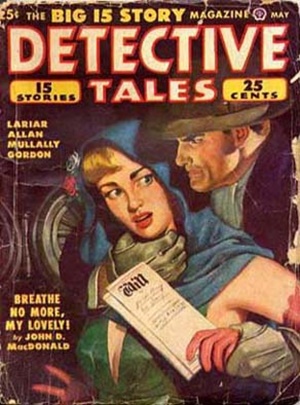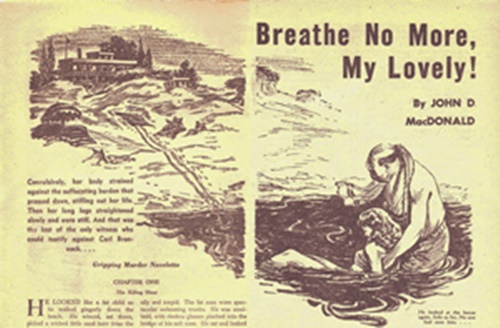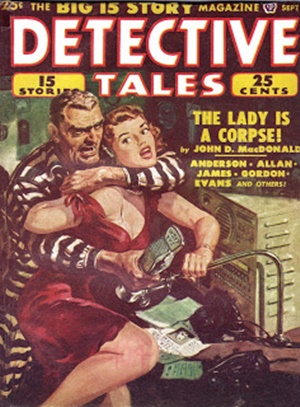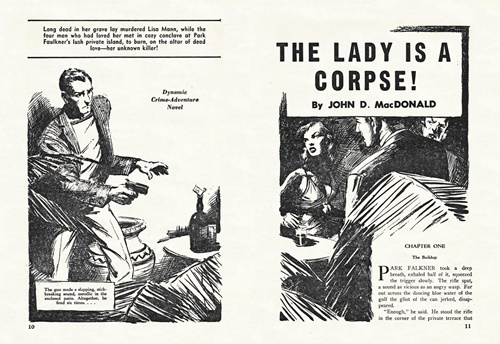A (Black) Gat in the Hand: Steve Scott on John D. MacDonald’s ‘Park Falkner’
 “You’re the second guy I’ve met within hours who seems to think a gat in the hand means a world by the tail.” – Phillip Marlowe in Raymond Chandler’s The Big Sleep
“You’re the second guy I’ve met within hours who seems to think a gat in the hand means a world by the tail.” – Phillip Marlowe in Raymond Chandler’s The Big Sleep
(Gat — Prohibition Era term for a gun. Shortened version of Gatling Gun)
Steve Scott runs The Trap of Solid Gold. It’s not just a blog dedicated to my favorite author. It’s THE blog dedicated to the late, great John D. MacDonald. It is absolutely the best place on the web to read about JDM. Period. I was going to do a post on an early, quickly aborted attempt by MacDonald to write a series character – if two stories qualifies as a series. Then I remembered, I had read a post by Steve on one of those stories. Turns out, he’d covered both of them. And his essays were FAR better than anything I could have come up with. So, I got permission from Steve to combine them and run a long post as part of A (Black) Gat in the Hand. Woohoo! Read on about the not-a-private eye, Park Falkner
Story One – “Breathe No More My Lovely”
Long before Travis McGee was even a random thought in the mind of author John D MacDonald, before he had established himself as a first-rate writer of crime fiction, before he had even a full year of life as a published author, MacDonald began experimenting with a “series” character. In two early Doc Savage submissions, “Private War” in December 1946 and “Eight Dozen Agents” in January 1947, he created a hero he called Benton Walters. Having never read either of these stories, I don’t know if Walters was a private eye, a secret agent or a super hero.
According to Ed Hirshberg, he was a “war veteran… working at a humdrum civilian job somewhere in the northeastern United States…” who was disillusioned with his “unexciting” postwar job. Sounds like a great idea for a series. I do know that MacDonald quickly dropped the idea, writing to Babette Rosmond (the editor of Doc Savage):
“Honest to God — I’m never going to start another series. They are limiting and I hate them.”
Sixteen years later Travis McGee was attempting to have a quiet evening a home while Chookie McCall was dancing up a storm in the lounge of The Busted Flush.
But it didn’t take MacDonald that long to renounce his promise to Rosmond. As early as 1950 he tried again, creating Park Falkner, a fantastically wealthy playboy who first appeared in a story called “Breathe No More, My Lovely,” published in the May 1950 issue of Detective Tales. It’s a great bit of pulp writing with a wild, improbable plot, and a bit of business that he would use again in his 1956 novella Linda (with a few changes). And a hero that really would have been worth following in a series of stories. As it turned out, Park Falkner appeared only one more time, four months later, before disappearing forever. Too bad.
He’s an unlikely hero, closer to Doc Savage than to Travis McGee, although there are a lot of similarities to MacDonald’s later hero:
“He was tall and hard and fit, a man in his mid-thirties, his naked body marked with a half dozen violent scars. He was sun-darkened to a mahogany shade. A tropical disease had taken, forever, hair, eyebrows, and lashes, but the bald well-shaped head seemed to accentuate the youthfulness of his face. The lack of eyebrows and lashes gave his face an expressionless look, but there was rapacity in the strong beaked nose, both humor and cruelty in the set of the mouth.”
Falkner is a very wealthy bachelor, the owner of a fortune created by his “esteemed ancestors [who] had the golden touch.” He lives on Grouper Island — he also owns Grouper Island — which is connected to the West Florida mainland by his own private causeway. He has more money than he can ever spend in this lifetime, but the company of other rich people bores him to tears. He has no interest in trying to make himself richer by working, so what does he do?
He hires “clever young men” to dig into the “disorderly pasts” of certain people, and when they come up with something Falkner devises a way to ingratiate himself into their lives. He eventually invites them for a short stay at his island estate, then, “…I just mix some human ingredients together and see what happens. A tossed salad of emotions, call it.”
Aided by his driver/pilot, an ex-boxer named Lew Cherezack, and his sometimes-girlfriend, a silver-haired fortysomething beauty who goes by the name of Taffy Angus, Park Falkner is ready to play “…amateur cop or … god of vengeance. Take your choice. Flip a coin…”
 In “Breathe No More, My Lovely,” Falkner has uncovered a Mississippi land developer who came by his own wealth through a con performed seven years ago under a different identity. This man, now going by the name of Carl Branneck, worked the old badger game with an accomplice named Laura Hale, and once the fleece was completed Branneck ran off with the money, leaving Laura penniless. Laura reported the crime to police and turned herself in, but the authorities were unable to locate Branneck. Falkner, however, has managed to find both of them and masquerades as a potential client in order to lure Branneck to Grouper Island for a long weekend. Separately he has used a different pretext to invite Laura. Neither person knows the other will be there.
In “Breathe No More, My Lovely,” Falkner has uncovered a Mississippi land developer who came by his own wealth through a con performed seven years ago under a different identity. This man, now going by the name of Carl Branneck, worked the old badger game with an accomplice named Laura Hale, and once the fleece was completed Branneck ran off with the money, leaving Laura penniless. Laura reported the crime to police and turned herself in, but the authorities were unable to locate Branneck. Falkner, however, has managed to find both of them and masquerades as a potential client in order to lure Branneck to Grouper Island for a long weekend. Separately he has used a different pretext to invite Laura. Neither person knows the other will be there.
The reader doesn’t know any of this background at the beginning of the story. For the first four pages we witness a solitary Branneck on the beach near Falkner’s palatial estate, watching an equally-solitary Laura Hale asleep on the beach enjoying the sun. Once he has determined that no one is watching him, he quickly covers Laura’s face with sand, thrown a towel over her and pins her to the beach as she suffocates. He then drags her body to the Gulf and takes her several hundred yards out, fills her lungs with sea water and leaves her there.
It is only after the body is discovered that Park reveals what he was planning to do. He wanted to bring the two together and watch their reactions. Just as he suspected, Laura saw a fortune and Branneck saw ruin. There are a few unusual aspects to Laura’s death that lead Falkner to suspect that Branneck was responsible, and once he deduces how it was done he plans a way to get Branneck to admit to the crime. If you’ve read Linda who have a good idea how, only not with a tape recorder.
The final half of this 8,800-word story is an exciting and suspenseful cat-and-mouse game that leads to a great chase and a tidy ending. It’s everything a reader would want in a series character. Unfortunately Park Falkner appeared once more, in a story called “The Lady is a Corpse” before vanishing forever.
I’m not sure why MacDonald stopped. In October of 1950 he published his first novel, The Brass Cupcake, so perhaps he didn’t want to get bogged down with a continuing short story hero. According to Hugh Merrill, Fawcett asked him to consider doing yet another series character in 1952, this time for paperback, but MacDonald refused. “I had the uneasy feeling,” he said later, “that were I to come up with a successful series, I might be stuck with it, unable to sell work of any other kind. I think my hunch was valid.”
Considering the fact that MacDonald is known for little else these days, I think his hunch was valid.
“Breathe No More, My Lovely” was submitted to Doc Savage under the title “Breathe No More,” but was changed by editors in an obvious attempt to reference Raymond Chandler’s Farewell My Lovely. MacDonald restored his original title when he anthologized it in the first volume of The Good Old Stuff.
Story Two – “The Lady is a Corpse!” (“From Some Hidden Grave”)
 “The Lady is a Corpse” was the second and final Park Falkner story, written by John D MacDonald and published in the September 1950 issue of Detective Tales.
“The Lady is a Corpse” was the second and final Park Falkner story, written by John D MacDonald and published in the September 1950 issue of Detective Tales.
Falkner’s method to ward off the “sickening boredom” of his life is to play the part of “amateur cop or god of vengeance… take your pick.”
It was clearly a self-limiting formula and one that could not have been sustained over many more efforts without a lot of adjustments. Falkner’s methods involve learning about an unsolved crime or disappearance, having his investigators dig up as much background as possible — far more that the usually-disinterested police are able to — and inviting the suspects under false pretenses to his fortress-like beach estate on the west coast of Florida. Then, “I just mix some human ingredients together and see what happens. A tossed salad of emotion, call it.”
Falkner is extra careful to avoid mistakes (this time around). But that may not be enough, for in the first case he already knew who the bad guy was. Now, he’s out to reveal which of four friends murdered a young woman.
The four suspects are Bill Hewett, a “tall, frail, gangly” copywriter for TV commercials, Prine Smith, a “dark, stocky, muscular” newspaper reporter, Guy Darana, a hulky, pretty boy stage actor, and Stacy Brian, a “jittery, hyperthyroid” redhead who works in radio (dramatic radio… this was written in 1950, after all). It happened nine months ago in New York City, and Falkner lays his cards face up on the table when the four men arrive:
“The four of you lived in a big apartment in the Village, two blocks from Sheridan Square. You’ve split up now, but that was the status quo. Hewett had a girlfriend, lovely from all reports, named Lisa Mann. On a hot afternoon, June fourth to be exact, Lisa Mann, using a key that Hewett had given her, let herself into the apartment. A girl named Alicia French happened to see her. Alicia lived in the next apartment down the hall. All four of you were able to prove that you were out that afternoon. The first one to get back to the apartment was Guy Darana. He returned a little after eleven that night. No one has seen Lisa Mann since. Apparently she never returned to her own apartment. There was an investigation. Her parents are well-to-do. I asked you four down here because things like that intrigue me. I hope that during your stay here one of you will, directly and indirectly, admit to his guilt in the death of Miss Mann.”
Prine Smith responds by asking, “Are you crazy?”
What Falkner hasn’t told them is that he has hired two young beach bunnies to pretend to be his nieces. Their jobs are to cozy up to the men, to play them off against each other in an attempt to cause some interesting friction. Once the men settle in, the games begin.
As in the previous tale, Falkner is assisted by his retune of Doc Savage-like friends: his girlfriend, the silver-haired Taffy Angus, his right-hand-man Lew Cherezack — an ex-boxer and driver/pilot/boat captain, Lew’s wife (the cook) and Francie the maid. Taffy, as before, is constantly at Falkner, begging him to stop these games and to just relax and spend his fortune. All the action takes place on Grouper Key, Park’s private island connected to the mainland by a causeway, and he gets around on either his amphib, one of his many boats, or his fleet of automobiles. The house features all the amenities of a Club Med, including tennis, swimming (pool or Gulf), badminton and oceans of booze.
 All but Hewett, who is clearly disturbed by the reminder of Lisa’s murder, settle in and begin enjoying themselves. Taffy is uneasy but the four men quickly begin acting as Falkner intended. “They’re drinking too much and laughing too loudly, and they’re all wound up like a three-dollar watch. We just wait and see.”
All but Hewett, who is clearly disturbed by the reminder of Lisa’s murder, settle in and begin enjoying themselves. Taffy is uneasy but the four men quickly begin acting as Falkner intended. “They’re drinking too much and laughing too loudly, and they’re all wound up like a three-dollar watch. We just wait and see.”
Throughout the narrative MacDonald utilizes a unique (for him) device of inserting the murderer’s thoughts at various points along the way. The sentences are italicized, the paragraph is formatted with double-indentation and the words are coming from the head of one of the four men. That man is clearly a prototype for MacDonald’s Soulless Evil Villain, the kind of bad guy the author used throughout his career, a character who is a manifestation of “blackness for its own sake.”
We got a hint of him in The Brass Cupcake and met him fully formed in Dead Low Tide. There is a version of him in All These Condemned and we’ll meet him again along the way in April Evil, several Travis McGee adventures and, most memorably, in The Executioners.
“The Lady is a Corpse” was published only a month before The Brass Cupcake in 1950 and this device of a bad guy with “no redeeming features in their commitment to wrong-doing” (Hirshberg) was probably an idea whose genesis came around the time he began writing novels.
The character of Taffy Angus takes an interesting turn in this particular story, perhaps mirroring MacDonald’s exhaustion with the Park Falkner formula. She asks, then pleads with her lover to quit “playing God” and to turn everything over to the police, but Falkner is clearly having too much fun. He’s obviously got a social gene missing somewhere in his need to control and manipulate, despite his protestations that he’s working for the greater good.
At one particularly ugly point in the story Taffy tells Falkner she’s through with him and will be leaving the next morning. Perhaps she — like the author — ultimately realized that Park Falkner is really not a very nice guy.
“The Lady is a Corpse” was anthologized in the first volume of The Good Old Stuff and appears under the author’s original title, “From Some Hidden Grave.”
Prior posts in A (Black) Gat in the Hand – 2019 Series
Back Deck Pulp Returns
A (Black) Gat in the Hand Returns
A (Black) Gat in the Hand: Will Murray on Doc Savage
A (Black) Gat in the Hand: Hugh B. Cave’s Peter Kane
A (Black) Gat in the Hand: Paul Bishop on Lance Spearman
A (Black) Gat in the Hand: A Man Called Spade
A (Black) Gat in the Hand: Hard Boiled Holmes
A (Black) Gat in the Hand: Duane Spurlock on T.T. Flynn
A (Black) Gat in the Hand: Andrew Salmon on Montreal Noir
A (Black) Gat in the Hand: Frank Schildiner on The Bad Guys of Pulp
A (Black) Gat in the Hand – 2018 Series
With a (Black) Gat: George Harmon Coxe
With a (Black) Gat: Raoul Whitfield
With a (Black) Gat: Some Hard Boiled Anthologies
With a (Black) Gat: Frederick Nebel’s Donahue
A (Black) Gat in the Hand: Thomas Walsh
A (Black) Gat in the Hand: Black Mask – January, 1935
A (Black) Gat in the hand: Norbert Davis’ Ben Shaley
A (Black) Gat in the Hand: D.L. Champion’s Rex Sackler
A (Black) Gat in the Hand: Dime Detective – August, 1939
A (Black) Gat in the Hand: Back Deck Pulp #1
A (Black) Gat in the Hand: W.T. Ballard’s Bill Lennox
A (Black) Gat in the Hand: Day Keene
A (Black) Gat in the Hand: Black Mask – October, 1933
A (Black) Gat in the Hand: Back Deck Pulp #2
A (Black) Gat in the Hand: Black Mask – Spring, 2017
A (Black) Gat in the Hand: Frank Schildiner’s ‘Max Allen Collins & The Hard Boiled Hero’
A (Black) Gat in the Hand: William Campbell Gault
A (Black) Gat in the Hand: More Cool & Lam From Hard Case Crime
A (Black) Gat in the Hand: MORE Cool & Lam!!!!
A (Black) Gat in the Hand: Thomas Parker’s ‘They Shoot Horses, Don’t They?’
A (Black) Gat in the Hand: Joe Bonadonna’s ‘Hardboiled Film Noir’ (Part One)
A (Black) Gat in the Hand: Joe Bonadonna’s ‘Hardboiled Film Noir’ (Part Two)
A (Black) Gat in the Hand: William Patrick Maynard’s ‘The Yellow Peril’
A (Black) Gat in the Hand: Andrew P Salmon’s ‘Frederick C. Davis’
A (Black) Gat in the Hand: Rory Gallagher’s ‘Continental Op’
A (Black) Gat in the Hand: Back Deck Pulp #3
A (Black) Gat in the Hand: Back Deck Pulp #4
A (Black) Gat in the Hand: Back Deck Pulp #5
A (Black) Gat in the Hand: Joe ‘Cap’ Shaw on Writing
A (Black) Gat in Hand: Back Deck Pulp #6
A (Black) Gat in the Hand: The Black Mask Dinner
Steve Scott is the most knowledgeable John D. MacDonald person I know, and his blog, The Trap of Solid Gold is, quite simply, must reading. There’s not a better way to learn about John D. MacDonald’s works (and subsequently, why JDM was one of the best writers of the twentieth century, period), than Steve’s ruminations. If you are a MacDonald fan, you should be regularly checking his blog. If you’re not a fan, what’s wrong with you?
 Bob Byrne’s ‘A (Black) Gat in the Hand’ was a regular Monday morning hardboiled pulp column from May through December, 2018 and was brought back in the summer of 2019.
Bob Byrne’s ‘A (Black) Gat in the Hand’ was a regular Monday morning hardboiled pulp column from May through December, 2018 and was brought back in the summer of 2019.
His ‘The Public Life of Sherlock Holmes’ column ran every Monday morning at Black Gate from March, 2014 through March, 2017 (still making an occasional return appearance!).
He organized ‘Hither Came Conan,’ as well as Black Gate’s award-nominated ‘Discovering Robert E. Howard’ series.
He is a member of the Praed Street Irregulars, founded www.SolarPons.com (the only website dedicated to the ‘Sherlock Holmes of Praed Street’) and blogs about Holmes and other mystery matters at Almost Holmes.
He has contributed stories to The MX Book of New Sherlock Holmes Stories – Parts III, IV, V and VI.
And he contributed to The New Adventures of Solar Pons.